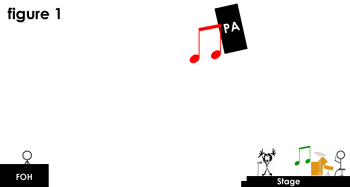
A Visual Approach to Alignment
I’ve gotten a few emails about the whole time alignment thing, and I think it might be easier to understand in a visual context. In order to figure out how to delay everything properly, I actually had to diagram it out so here’s a slightly fancier version than what I used to do it in the first place.

Here’s the scenario. In Figure 1 the drummer has just pounded his snare. The sound created on stage immediately begins travel towards FOH with the reproduced sound coming from the PA immediately after.
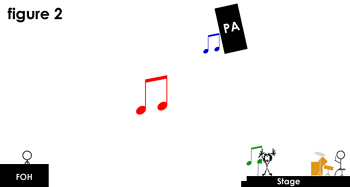
Moments later in Figure 2, we see that the sound from the PA and drums has moved forward in space towards FOH. When the drum sound arrives at the lead vocal mic, the sound is picked up and reproduced through the PA again. As you can see, we now have three instances of the transient in the room all moving towards the audience and FOH.
On a side note, keep in mind that as each of those transients moves through the room, they will be reflecting off the surfaces in your room creating even more arrival times at FOH. While the best way to deal with those reflections might be acoustic treatment, I think doing some alignment on your PA with the stage sound will probably be a big step in the direction of cleaning up your sound a bit.
But getting back to it, let’s see what we’re going to hear at FOH. The diagram labeled Arrival Figure 1 makes this a little clearer.
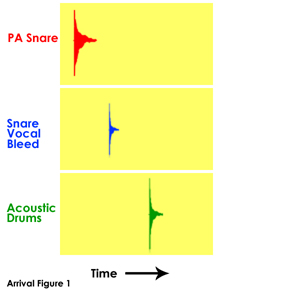
Here we see a snare transient and its three different arrival times at FOH. Two of the transients are coming from our PA; “PA Snare” is the reproduced snare sound coming from the close mic on the snare (essentially the snare channel), and “Snare Vocal Bleed” is the snare drum bleeding into the vocal mic (essentially the lead vocal channel). “Acoustic Drums” is the sound of the drums being played in the room coming off the stage. While we can’t control the timing of the acoustic drums arriving, we can electronically manipulate the arrival times of the “PA snare” and the “Snare Vocal Bleed”.
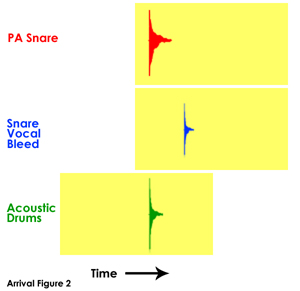
Arrival Figure 2 shows the results of my first step. I have delayed the entire PA to align it with the acoustic stage sound from the drums. I apply a uniform channel delay to all the music channels, and the PA Snare and Snare Vocal Bleed are “pushed” back in time so that the wavefront begins to unify. Even if your present mixing situation only allows you to delay the entire PA, I think you’re still going to be in a better place because now you only have two arrival times for that snare at FOH. Plus if you take steps to cut down on bleed in your vocal mics (drum shields, tight pattern mics, good technique, etc.), that second arrival probably isn’t going to be as big a deal as your acoustic drum energy and the PA drum energy being out of time.
But some of us have the tools so we will take this one step farther. In Arrival Figure 2, you can see that the vocal bleed snare is later in time than the actual snare. The first instinct I had was to delay the snare mic so that it gets pushed back to the bleed. However, the problem with that is it would knock the time alignment between the PA and the acoustic drums off. Arrival Figure 3 shows my solution.
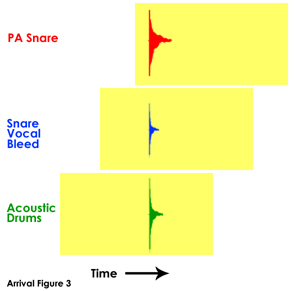
By reducing the delay I applied to the vocal mic, I bring that snare bleed forward creating a unified snare wavefront.
There might be a better approach to this, but this is what I did last week and I’m repeating it again this week. When I began approaching this, I knew it would be important for me to handle the PA alignment first because at the time I needed a live drummer (I might have a workaround for that now, though). I knew I could do the alignment stuff amongst the instruments later after I had a recording of a rehearsal and Pro Tools to easily measure the offsets I would be correcting.
If you want to find out more about this from folks with a lot more experience than me (it’s week 2, baby), I would suggest starting with an article over at Siasoft’s site. The article is by Ted Leamy, and he talks about using time correction with Lenny Kravitz using Smaart to handle measurements. Ted has some good practical steps towards making measurements that I will probably try next week; I’m going to have to dig a wedge out of storage to do it, though….


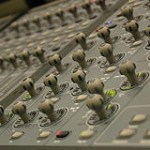 Previous Post
Previous Post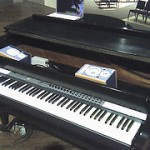 Next Post
Next Post



hey dave like the posts i due some delaying too on my console for time alighnment quick question have u had any problems withthe band saying anything with their ears. I havent but has been a concern for me since our pa is directly above our band. Also i know yall are kind of like ujs with set changes and stuff are u going to correct your time delays everytime u move the drum kit? Or are u trying to keep the kit in the same position. I am still going to try and shell out sometime to come down and see u it has been so crazy around here still since the unleash conference and i have gma coming up in a few weeks hope u are doing well ! I am keeping u and the audio staff at north point in my prayers cant wait to actually meet face to face one day!
I haven’t heard any complaints from the band about the delay, and I think that they just don’t hear as much from the PA with the IEMs, although they can definitely “feel” when the PA is on. Now there was a point about a week ago when one of our music directors was on stage fiddling with our borrowed fake piano (photos are coming), and he didn’t have IEMs. I believe he was pretty shocked by the latency, but still no complaints.
My plan is to re-correct the time delays everytime we move the drums. This is why I’m doing it in the Venue instead of system processing. The Venue channel delays are much more accessible than system processing so it will be easier to do on a more frequent basis. Plus, this is something I want to teach our volunteer A1’s, and I don’t want them fiddling in our system processing. Our sets typically change with each series so I’ll get 3-6 weeks out of a setting.